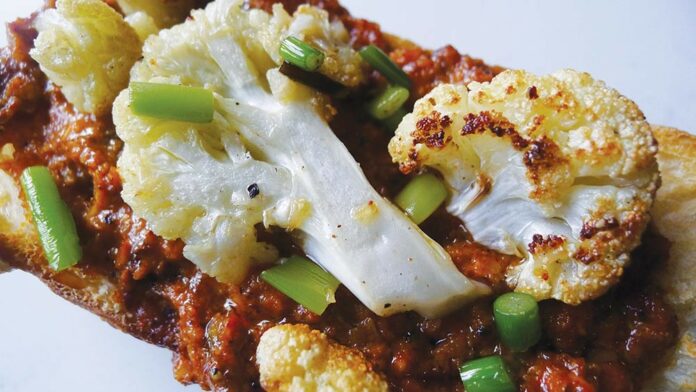Romesco sauce, one of Catalonia’s finest exports, is renowned as a dressing for seafood.
But the red, nutty condiment improve almost any savory dish it touches, including vegetables, starches and proteins of all persuasions. Invented by fishermen centuries ago, soon after the arrival of new world tomatoes and peppers, it also includes almonds, olive oil, garlic, wine vinegar and stale bread. Every one of those ingredients have been in ready supply in California for years, as has been romesco sauce. The appearance of Mexican romesco was inevitable.
One celebrated formulation debuted soon after Napa Valley restaurateur Cindy Pawlcyn hired the Jacinto brothers, Ernest and Pablo, to run the kitchen of Mustard’s Grill, Their south-of-the-border version of the Catalonian sauce was on the menu for years, and was revered valley-wide.
The modification from Spanish to Mexican romesco is slight, but significant: dried red chile instead of fresh red bell pepper. This change thickens the romesco, adding pungency and spice. “Everything else in the sauce comes from Spain,” explained my friend Marianne Forest, who learned the recipe from Pawlcyn.
A restaurateur herself, I was thrilled when Forest agreed to come to my house and show me how to make Jacinto-style romesco. When the time came to cut a tomato, she reached smoothly into the jungle of utensils at the edge of my counter and extracted my only tomato knife, as if pulling a rabbit from a hat. She used the serrated blade to cut a cross on top of each tomato.
Soon those cuts would help the skins slip off easily, after the tomatoes were broiled and then cooled. In the meantime, almonds would be roasted, a hunk of sourdough would be griddled, and heads of garlic baked in olive oil. “Everything is roasted or toasted,” Marianne said.
Marianne put the ingredients in the blender in no particular order. Every few moments she would inspect the slurry with a spoon, gauging progress by the diminishing diameter of the largest pieces of almond. “You want rustic saucery. It should not be homogenous, or liquefied.”
Before I knew it, we were eating crunchy romesco sauce. It was delicious and complete off the spoon, with a vibrant mix of full flavors.
Per Marianne’s advice, I smeared romesco on a piece of crusty toast soaked in olive oil. This simple combination could be a complete meal, but is also a starting point, and a crossroads. Atop that romesco-smeared toast there remained room for additional morsels of food, like grilled asparagus, roasted cauliflower or a few leaves of spicy greens.
Since then I have noticed a pattern: when bread and romesco sauce are both within reach, I will keep eating until one of them runs out. The same is true when I’m dipping veggies in romesco. And when all available substrates are gone, there is still that spoon.
Romesco Jacinto
The original recipe contains toasted bread. As a gluten-free alternative, Marianne suggested adding extra almonds and skipping the bread. I tried that and preferred that version, especially when gluttonously smeared on a glutenous hunk of toasted sourdough.
Romesco Jacinto was made with whole dried chile pods, but since chile powder makes a decent batch too, and is easier to get, the directions call for powder.
As the level of heat in a dish is subjective, the recipe calls for two tablespoons of red chile of a heat you can handle. It could be a tablespoon and a half of mild paprika mixed with half a tablespoon of spicy Cayenne, for example. Or two tablespoons of hot red chile powder if you are a raving lunatic.
If you wish to use whole dried chile, find a variety with the right balance of heat and flavor for your taste. Marianne likes New Mexico and Ancho peppers. Use two good-sized pods. Remove the seeds, toast in a pan, and soak in water to rehydrate.
Serves 4
One ¾-lb tomato (or a collection of smaller tomatoes)
One large head of garlic, separated into cloves and peeled
1 cup olive oil
1 cup almonds (or half a cup of almonds and a slice of toast)
2 tablespoons red chile powder (a variety, or mix, that delivers a heat level you can handle)
2 tablespoons red wine vinegar
½ teaspoon salt
Optional: a piece of white bread
Turn the oven to broil. Cut an X on the top of the tomatoes, with the stem scab right in the middle, and place them six inches below the flame. Leave there until you smell something faintly starting to burn, about 10-15 minutes—start paying close attention after 10. When the peels start to dry and even char, turn the tomatoes over and cook similarly.
While the tomatoes are broiling, pour ½ cup of the olive oil into a small baking dish and add garlic cloves. When the tomatoes are charred on both sides, remove them, turn the oven temperature to 300 degrees on bake setting, and put the pan of garlic and oil in the oven. Bake at 300 for 20 minutes. Turn off the heat and leave in the oven to cool.
While the garlic roasts, toast the almonds in a dry, thick-bottom pan on medium-high. Just a few nearly-burnt almonds gives the sauce a rustic flavor, but it should not taste burnt. If using bread, pan-fry it in olive oil to slightly brown.
Add all of the roasted, toasted ingredients—all ingredients but the last ½ cup of olive oil—to the blender or food processor. Blend on low for 30 seconds, until the almonds are roughly chopped in half. Add the last ½ cup of oil and blend on high for about 5 seconds, or until the almond chunks are three millimeters or less.
Serve at room temperature with anything savory, like grilled or roasted vegetables, scrambled eggs, and/or that crusty, oily piece of bread.











